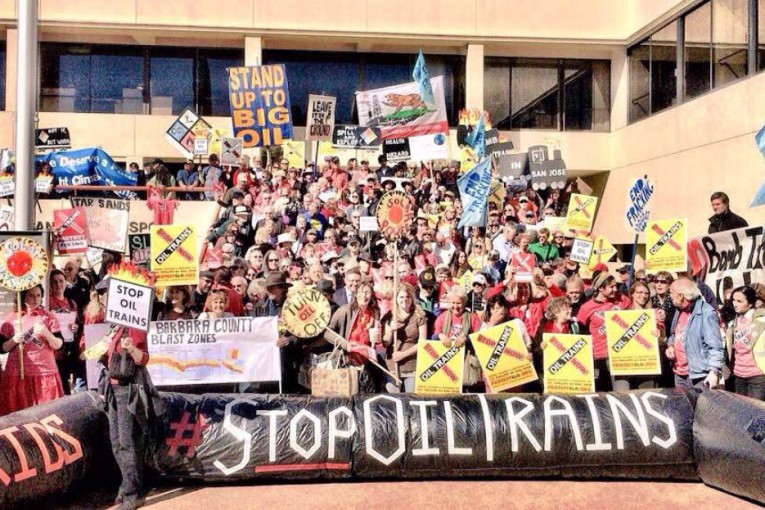

by Elizabeth Lasensky
The San Luis Obispo County Planning Commission and the City of Benicia Planning Commission heard public comment this month on two very similar oil train requests from refineries.
Both the Phillips 66 refinery in San Luis Obispo County and the Valero refinery in Benicia requested rail spurs to allow them to bring in oil trains. They would use existing Union Pacific Railroad tracks from the source of the crude to the edge of the refineries. From there the spurs would carry the oil trains into the refineries. Neither Phillips 66 nor Valero extracts crude. They purchase Bakken, Canadian tar sands or other crude, which must travel thousands of miles to the refineries.
Both rail spurs were to be on private, oil refinery property and both projects would have created relatively few permanent jobs. At the same time, each had many significant and unavoidable findings pertaining to environmental and safety issues. In each case, the applicant claimed that there was nothing that the local jurisdictions could do to require mitigation efforts. They cited federal pre-emption rights by the railroads dating back to the creation of the railroads. These pre-emption rights prohibit local and state governments from impeding railroad business. And of course, each refinery touted those few jobs.
It is through CEQA, the California Environmental Quality Act, that we, the citizens, have the right to be heard on such important developments in our communities. The review of such projects centers on their environmental and safety impacts and whether those impacts are outweighed by benefits.
Thanks to efforts by Lynne Nittler, we here in Davis were mobilized early. We had excellent local media coverage and were connected to the larger organizing efforts of the Center for Biodiversity, ForestEthics and the Sierra Club. Many of our public officials and agencies, local residents and organizations responded with comment letters to the EIRs (Environmental Impact Reports), Draft EIRs, Revised Draft EIR (Benicia), and Final EIRs for these two proposals..
I attended recent hearings in San Luis Obispo and spoke on February 4. Less than 48 hours before the deliberations were to begin, Phillips 66 sent a revised proposal offering to bring in three trains per week rather than the initially requested five. The County staff and the public were skeptical of this proposal.
The staff of the San Luis Obispo County Planning Commission had this to say about the Phillips 66 project:
“There is a lack of specific overriding economic, legal, social, technological, or other benefits of the Project that outweigh the significant effects on the environment, as would be required to approve the Project Pursuant to Public Resources Code Section 21081.”
They recommended that the Final Environmental Impact Report (FEIR) not be certified and that the permit be denied. The staff did an excellent job of presenting its case to the planning commissioners and the public.
Opposition to the Phillips 66 project is so strong that 390 of us took out speaker cards for the two days of hearings. Speakers included elected officials from the Cities of San Luis Obispo, Santa Barbara, Goleta, San Jose, Paso Robles, Berkeley and other East Bay communities; Santa Clara County; and numerous school boards. Other speakers included candidates for the 24th Congressional seat, nurses, teachers, neighbors, a zoo keeper, environmental and non-profit groups, firefighters, and many residents of uprail communities. Several lawyers from non-profit groups, including the Stanford Law Clinic for the Center for Biological Diversity, presented strong cases against the applicant’s claim of “federal pre-emption” of railroads.
The City of Davis, our Yolo County Supervisors and SACOG (Sacramento Area Council of Governments) sent letters addressing their concerns.
I was fortunate enough to be heard on the first day. Due to the numbers of people wanting to be heard, additional hearing dates for later this month have been scheduled. We will need to wait until March to hear what the San Luis Obispo Planning Commission decides.
In Benicia, their staff recommended just the opposite. Fortunately their Planning Commission, after hours of listening to testimony from staff, the applicant and the public, voted unanimously to reject the FEIR and to deny the use permit. Lynne Nittler and Jean Jackman have covered this hearing in an earlier article.
We know that we have not heard the last of either of these projects. We also know that the CEQA law requiring public input and comment can work to ensure that citizens are heard, not just corporations. In both of these cases, democracy was on full display. Both were a tribute to the combined efforts of our opposition and to staff and volunteer planning commissioners for their time, diligence, courage and thoughtfulness.
Yet another thanks to all who have been active in protecting our communities from these obvious high risk proposals.
I applaud all the work done by the authors on both of these projects. I do wish to repeat that nobody should breathe a sigh of relief regarding the Benicia project which calls for two 50 cars trains per day. That project is very likely to move ahead due to the make up of the city Council where Valero will appeal. Davis needs to remain extremely vigilant in its concern and opposition to this project.